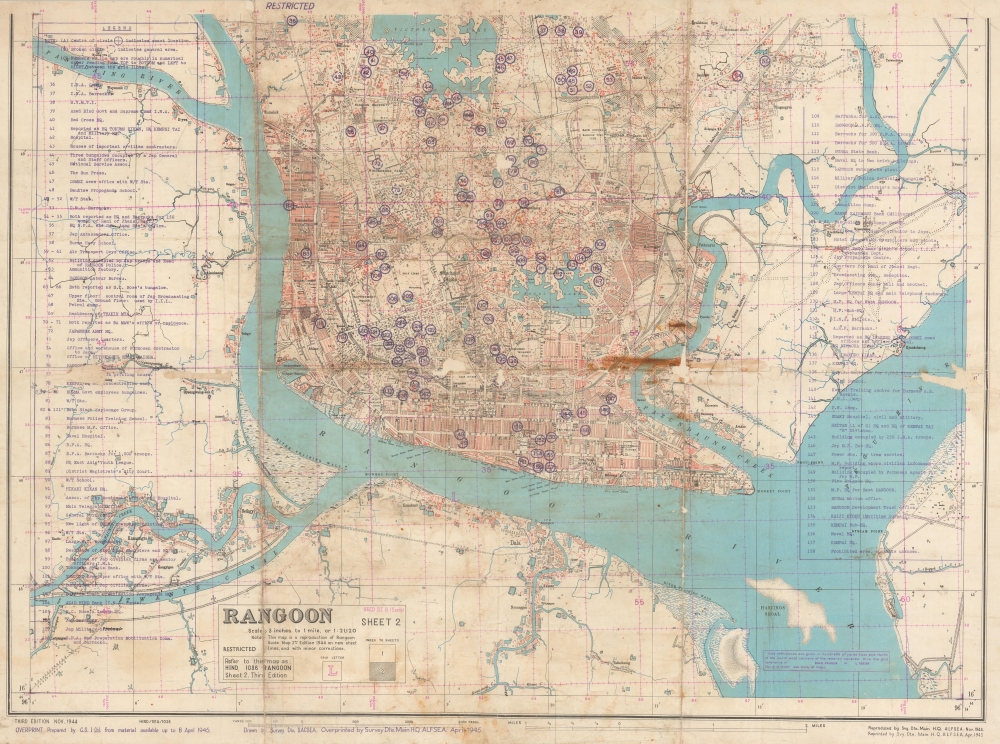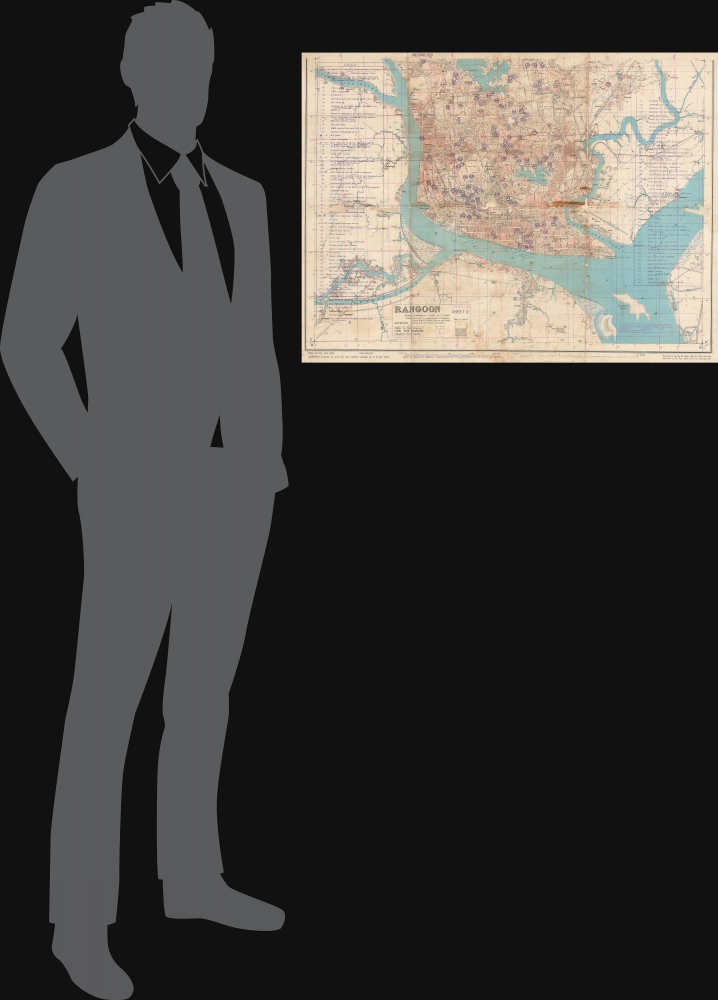This item has been sold, but you can get on the Waitlist to be notified if another example becomes available, or purchase a digital scan.
1945 Allied Land Forces South East Asia City Plan or Map of Rangoon, Burma (Myanmar)
RangoonSheet23rdEd-alfsea-1945$1,250.00

Title
HIND 1036 Rangoon Sheet 2. Third Edition.
1945 (dated) 23.25 x 31 in (59.055 x 78.74 cm) 1 : 21120
1945 (dated) 23.25 x 31 in (59.055 x 78.74 cm) 1 : 21120
Description
A unique survivor, this is an April 1945 Allied Land Forces South East Asia (ALFSEA) World War II pre-invasion intelligence map of Rangoon, Burma, identifying enemy locations. ALFSEA overprinting anticipates the May 1945 British assault on Rangoon, highlighting 122 key locations one month before the British retook the city: Indian National Army barracks and camps, Japanese military installations, Burmese government offices, a prisoner-of-war camp, and the barracks and headquarters of the Rani of Jhansi Regiment, the only women's regiment of the Indian National Army.
A Closer Look
The base map depicts Rangoon from Victoria Lake south to Hastings Shoal and from Kanaungto to Kwema. Among the landmarks identified are Rangoon University, Shwedagon, Windermere Park, the Cenotaph Museum, the zoo, the race course, hospitals, schools, and parks, among other sites.The Overprinting
The most interesting content is provided via diazo overprinting. The ALFSEA Main Headquarters Survey Department added the overprinting in April 1945. Over one dozen Indian National Army installations are marked, including both Subhas Chandra Bose's bungalow (#65, #66) and Bose's Indian H.Q. (#105). It also notes the H.Q. and barracks of the Rani of Jhansi Regiment (#54, #55) and more quarters for the Regiment (#126). Numerous Japanese army installations are noted, as are a dance hall and brothel frequented by Japanese officers, a hotel popular among officers and pilots, and Japanese military hospitals. Several installations are associated with the 'B.P.A.', including barracks and the headquarters of General Aung San, who led the Burmese Defense Army. It is likely that the 'P' should have been a 'D'. Burmese premier Ba Maw's office and residence are also marked.Subhas Chandra Bose, the Indian National Army, and the Burma Campaign
Subhas Chandra Bose (1897 - 1945) was an Indian nationalist and anti-colonial leader. During World War II, he allied with Nazi Germany and Imperial Japan in hopes of expelling the British from India. In 1942, Bose organized the Indische Legion (Indian Legion) in the German Army before leaving Germany via submarine to head the Japanese-sponsored Provisional Government of Free India. Bose and the Provisional Government fought the British in Burma and India, hoping to ignite a grassroots revolt, but British forces nonetheless defeated both the I.N.A. and the Japanese Army at the Battles of Imphal and Kohima, They then went on the offensive, eventually capturing Burma.The Rani of Jhansi Regiment
The Rani of Jhansi Regiment was the women's regiment of the Indian National Army. Subhas Chandra Bose announced the regiment's formation on July 12, 1943. The regiment, led by Captain Lakshmi Swaminathan, was trained in Japanese-occupied Singapore. By the war's end, the regiment numbered at least 1,000. Rani of Jhansi troops arrived in Rangoon in 1944 to support the Imphal Campaign and were tasked with caring for I.N.A. troops after the defeat. The regiment retreated with the rest of the Indian National Army after the fall of Rangoon.Publication History and Census
This is the 3rd edition of the Allied Land Forces South East Asia (ALFSEA) map of Rangoon and was published in 2 sheets in November 1944. We note 3 examples of the 3rd edition at Yale University, the British Library, and the National Library of Australia. The present map is, however, unique due to the April 1945 intelligence overprinting of Supreme Allied Command South East Asia (SACSEA). This is the only known surviving example that bears this overprinting.Condition
Fair. Backed on archival tissue for stability. Toning and soiling. Wear along original fold lines. Areas of infill with loss of text and printed image along central horizontal fold line. Slight infill along both vertical fold lines. Only 2nd sheet of 2 sheet map.
References
National Library of Australia MAP G7724.R3 1944. Yale University 596 R163 1944A. OCLC 557227396.




